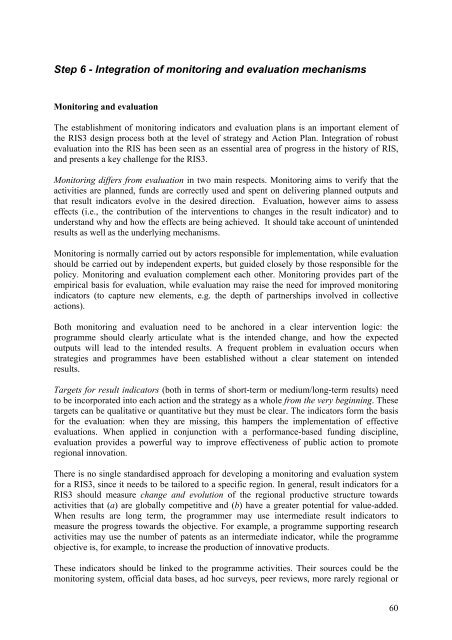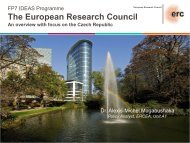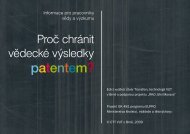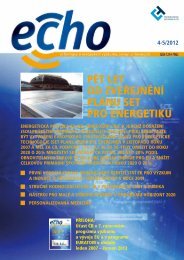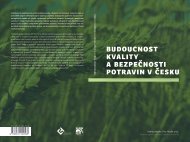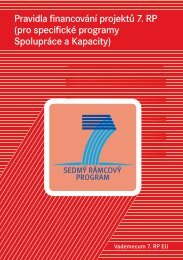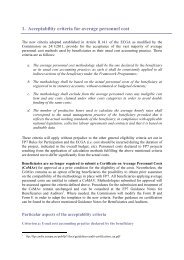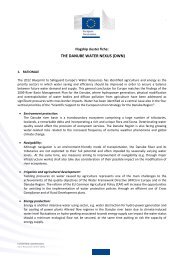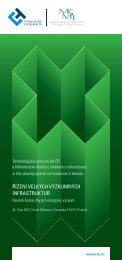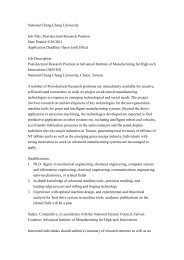Guide to Research and Innovation Strategies for Smart Specialisation
Guide to Research and Innovation Strategies for Smart Specialisation
Guide to Research and Innovation Strategies for Smart Specialisation
You also want an ePaper? Increase the reach of your titles
YUMPU automatically turns print PDFs into web optimized ePapers that Google loves.
Step 6 - Integration of moni<strong>to</strong>ring <strong>and</strong> evaluation mechanisms<br />
Moni<strong>to</strong>ring <strong>and</strong> evaluation<br />
The establishment of moni<strong>to</strong>ring indica<strong>to</strong>rs <strong>and</strong> evaluation plans is an important element of<br />
the RIS3 design process both at the level of strategy <strong>and</strong> Action Plan. Integration of robust<br />
evaluation in<strong>to</strong> the RIS has been seen as an essential area of progress in the his<strong>to</strong>ry of RIS,<br />
<strong>and</strong> presents a key challenge <strong>for</strong> the RIS3.<br />
Moni<strong>to</strong>ring differs from evaluation in two main respects. Moni<strong>to</strong>ring aims <strong>to</strong> verify that the<br />
activities are planned, funds are correctly used <strong>and</strong> spent on delivering planned outputs <strong>and</strong><br />
that result indica<strong>to</strong>rs evolve in the desired direction. Evaluation, however aims <strong>to</strong> assess<br />
effects (i.e., the contribution of the interventions <strong>to</strong> changes in the result indica<strong>to</strong>r) <strong>and</strong> <strong>to</strong><br />
underst<strong>and</strong> why <strong>and</strong> how the effects are being achieved. It should take account of unintended<br />
results as well as the underlying mechanisms.<br />
Moni<strong>to</strong>ring is normally carried out by ac<strong>to</strong>rs responsible <strong>for</strong> implementation, while evaluation<br />
should be carried out by independent experts, but guided closely by those responsible <strong>for</strong> the<br />
policy. Moni<strong>to</strong>ring <strong>and</strong> evaluation complement each other. Moni<strong>to</strong>ring provides part of the<br />
empirical basis <strong>for</strong> evaluation, while evaluation may raise the need <strong>for</strong> improved moni<strong>to</strong>ring<br />
indica<strong>to</strong>rs (<strong>to</strong> capture new elements, e.g. the depth of partnerships involved in collective<br />
actions).<br />
Both moni<strong>to</strong>ring <strong>and</strong> evaluation need <strong>to</strong> be anchored in a clear intervention logic: the<br />
programme should clearly articulate what is the intended change, <strong>and</strong> how the expected<br />
outputs will lead <strong>to</strong> the intended results. A frequent problem in evaluation occurs when<br />
strategies <strong>and</strong> programmes have been established without a clear statement on intended<br />
results.<br />
Targets <strong>for</strong> result indica<strong>to</strong>rs (both in terms of short-term or medium/long-term results) need<br />
<strong>to</strong> be incorporated in<strong>to</strong> each action <strong>and</strong> the strategy as a whole from the very beginning. These<br />
targets can be qualitative or quantitative but they must be clear. The indica<strong>to</strong>rs <strong>for</strong>m the basis<br />
<strong>for</strong> the evaluation: when they are missing, this hampers the implementation of effective<br />
evaluations. When applied in conjunction with a per<strong>for</strong>mance-based funding discipline,<br />
evaluation provides a powerful way <strong>to</strong> improve effectiveness of public action <strong>to</strong> promote<br />
regional innovation.<br />
There is no single st<strong>and</strong>ardised approach <strong>for</strong> developing a moni<strong>to</strong>ring <strong>and</strong> evaluation system<br />
<strong>for</strong> a RIS3, since it needs <strong>to</strong> be tailored <strong>to</strong> a specific region. In general, result indica<strong>to</strong>rs <strong>for</strong> a<br />
RIS3 should measure change <strong>and</strong> evolution of the regional productive structure <strong>to</strong>wards<br />
activities that (a) are globally competitive <strong>and</strong> (b) have a greater potential <strong>for</strong> value-added.<br />
When results are long term, the programmer may use intermediate result indica<strong>to</strong>rs <strong>to</strong><br />
measure the progress <strong>to</strong>wards the objective. For example, a programme supporting research<br />
activities may use the number of patents as an intermediate indica<strong>to</strong>r, while the programme<br />
objective is, <strong>for</strong> example, <strong>to</strong> increase the production of innovative products.<br />
These indica<strong>to</strong>rs should be linked <strong>to</strong> the programme activities. Their sources could be the<br />
moni<strong>to</strong>ring system, official data bases, ad hoc surveys, peer reviews, more rarely regional or<br />
60


